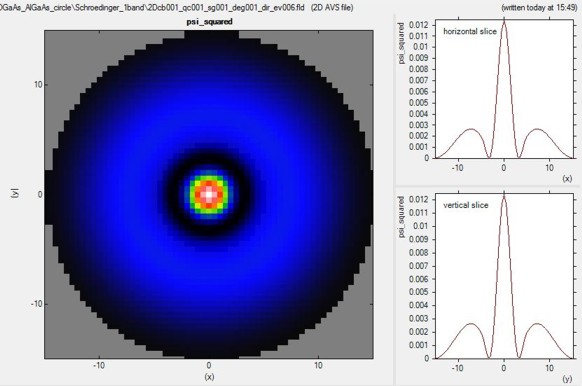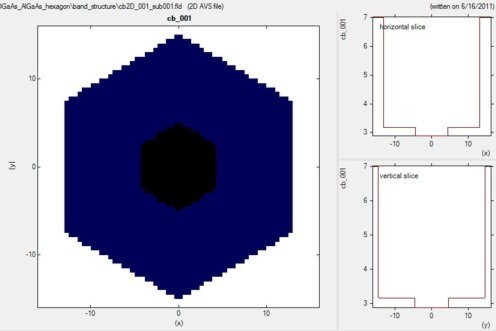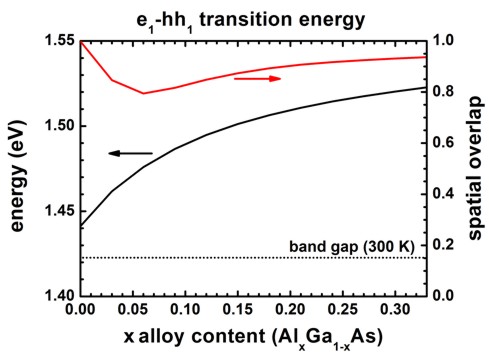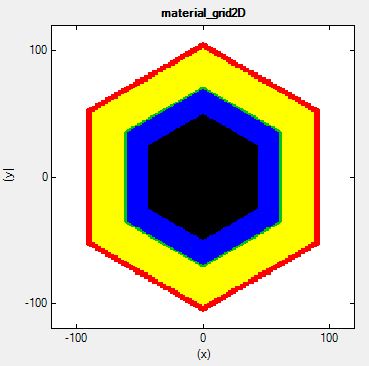Hexagonal GaAs/AlGaAs nanowires
- Input files:
2DGaAs_AlGaAs_circle_nnp.in
2DGaAs_AlGaAs_hexagon_nnp.in
2D_Hexagonal_Nanowire_2DEG_nnp.in
- Scope:
In this tutorial we simulate a circular and a hexagonal
core-shell structure (Part A) and a hexagonal nanowire structure (Part B). - Output files:
bias_00000\Quantum\probabilities_quantum_region_Gamma_.vtr
Part A: Schrödinger equation of a two-dimensional core-shell structure
In this part of the tutorial, we solve the two-dimensional Schrödinger equation of a circular and a hexagonal
Circular core-shell structure
Input file: 2DGaAs_AlGaAs_circle_nnp.in
Figure 2.4.163 shows the probability density of the 6th eigenstate of the circular

Figure 2.4.163
The
Hexagonal core-shell structure
Input file: 2DGaAs_AlGaAs_hexagon_nnp.in
Figure 2.4.164 shows the conduction band edge of the hexagonal

Figure 2.4.164 Conduction band edge profile of the hexagonal core-shell structure.
The diameter of the hexagonal shaped
Figure 2.4.165 shows the probability density of the 10th eigenstate of the circular

Figure 2.4.165
The hexagonal
Alloy sweep
Note
In comparison with nextnano³, nextnano++ does not support an alloy sweep in the input file. However, you can use nextnanomat’s Template feature to perform an alloy sweep.
In the following, we vary the alloy content

Figure 2.4.166 Transition energy and spatial overlap of e1 to h1 transition as a function of alloy content
The transition energies (e1 - h1), as well as the spatial overlap integral of the electron and hole ground state wave functions, are contained in this file: bias_00000\Quantum\momentum_matrix_elements_quantum_region_Gamma_001.txt
alloy type el-hl[eV] el[eV] hl[eV] matrix_element
0.330000 |<psi_vb001|psi_cb001_>|^2 1.522777615 2.965889676 1.443112062 0.936344908
0.300000 |<psi_vb001|psi_cb001_>|^2 1.520316794 2.963669699 1.443352905 0.931291593
...
The spatial overlap of electron and hole wave functions is always very high.
When there is only confinement due to the shell boundary, the matrix element is very high (99.8 %).
The matrix element must be smaller than 1 for
Part B: Hexagonal 2DEG - Two-dimensional electron gas in a delta-doped hexagonal shaped
Input file: 2D_Hexagonal_Nanowire_2DEG_nnp.in
The following example deals with a delta-doped

Figure 2.4.167 The material layers of the struture:
The self-consistently calculated conduction band edge (bandedges.fld) is shown in Figure 2.4.168. The horizontal and vertical slices through the center indicate the triangular potential well (conduction band minimum) where the 2DEG is located.

Figure 2.4.168 Conduction band edge profile.
The resulting 2DEG electron density (bias_00000\density_electron_fld) is shown Figure 2.4.169. At the corners, the electron density is significantly higher, thus one-dimensional conducting channels are formed. Although the structure itself has a hexagonal symmetry, our rectangular grid breaks this symmetry. Therefore the density in the upper/lower corner are different from the density at the left/right corners.

Figure 2.4.169 Charge density profile.
The 2D Poisson equation and the 2D Schrödinger equation have been solved self-consistently. The dimension of the Schrödinger matrix is 28,625. The CPU time for this calculation was about 18 minutes.
Last update: 27/05/2025